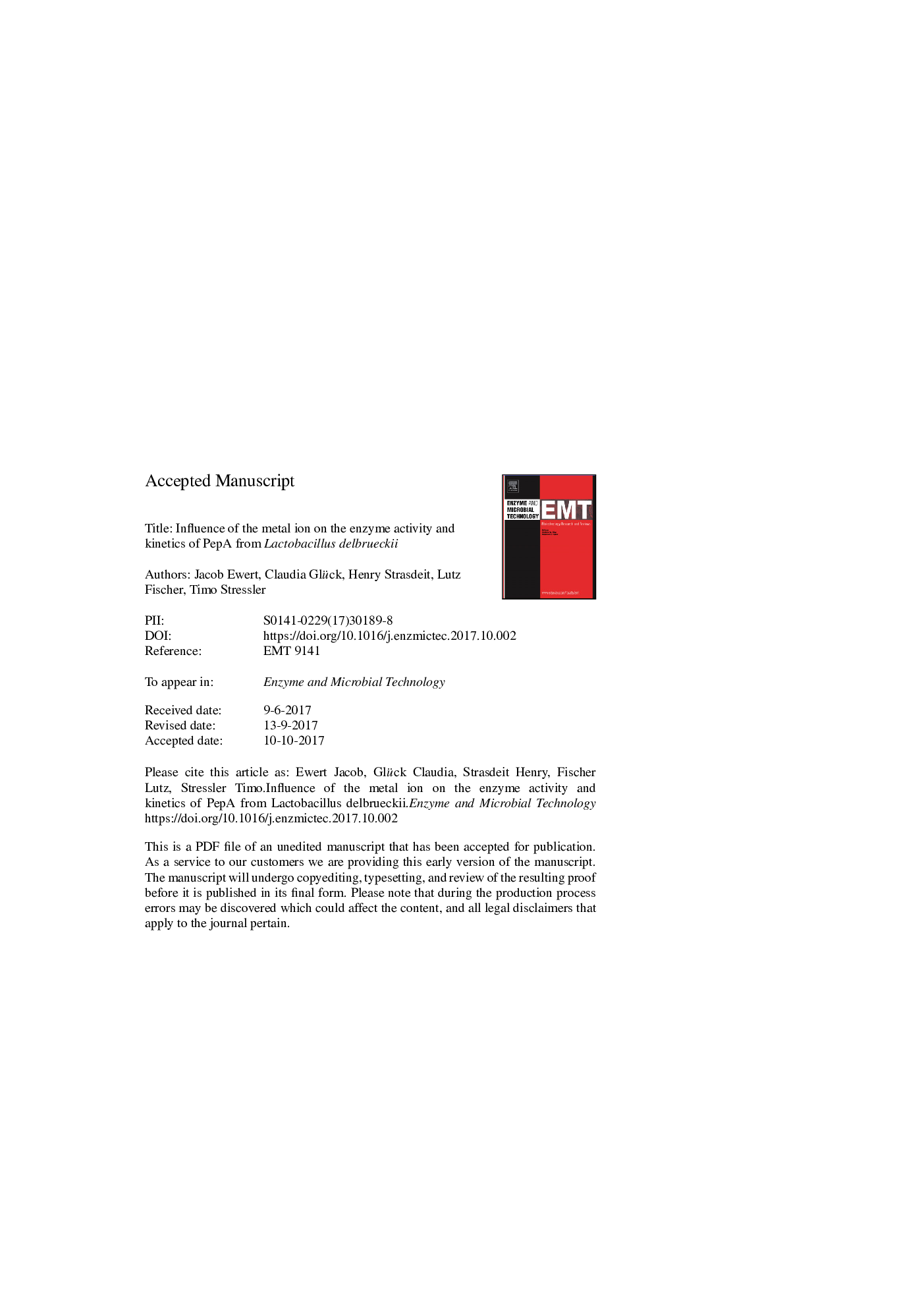| کد مقاله | کد نشریه | سال انتشار | مقاله انگلیسی | نسخه تمام متن |
|---|---|---|---|---|
| 6488189 | 1416361 | 2018 | 37 صفحه PDF | دانلود رایگان |
عنوان انگلیسی مقاله ISI
Influence of the metal ion on the enzyme activity and kinetics of PepA from Lactobacillus delbrueckii
دانلود مقاله + سفارش ترجمه
دانلود مقاله ISI انگلیسی
رایگان برای ایرانیان
کلمات کلیدی
موضوعات مرتبط
مهندسی و علوم پایه
مهندسی شیمی
بیو مهندسی (مهندسی زیستی)
پیش نمایش صفحه اول مقاله

چکیده انگلیسی
The aminopeptidase A (PepA; EC 3.4.11.7) belongs to the group of metallopeptidases with two bound metal ions per subunit (M1M2(PepA)) and is specific for the cleavage of N-terminal glutamic (Glu) and aspartic acid (Asp) and, in low amounts, serine (Ser) residues. Our group recently characterized the first PepA from a Lactobacillus strain. However, the characterization was performed using synthetic para-nitroaniline substrates and not original peptide substrates, as was done in the current study. Prior to the characterization using original peptide substrates, the PepA purified was converted to its inactive apo-form and eight different metal ions were tested to restore its activity. It was found that five of the metal ions were able to reactivate apo-PepA: Co2+, Cu2+, Mn2+, Ni2+ and Zn2+. Interestingly, depending on the metal ion used for reactivation, the activity and the pH and temperature profile differed. Exemplarily, MnMn(PepA), NiNi(PepA) and ZnZn(PepA) had an activity optimum using MES buffer (50 mM, pH 6.0) and 60 °C, whereas the activity optimum changed to Na/K-phosphate-buffer (50 mM, pH 7.0) and 55 °C for CuCu(PepA). However, more important than the changes in optimum pH and temperature, the kinetic properties of PepA were affected by the metal ion used. While all PepA variants could release N-terminal Glu or Asp, only CoCo(PepA), NiNi(PepA) and CuCu(PepA) could release Ser from the particular peptide substrate. In addition, it was found that the enzyme efficiency (Vmax/KM) and catalytic mechanism (positive cooperative binding (Hill coefficent; n), substrate inhibition (KIS)) were influenced by the metal ion. Exemplarily, a high cooperativity (n > 2), KIS value >20 mM and preference for N-terminal Glu were detected for CuCu(PepA). In summary, the results suggested that an exchange of the metal ion can be used for tailoring the properties of PepA for specific hydrolysis requirements.
ناشر
Database: Elsevier - ScienceDirect (ساینس دایرکت)
Journal: Enzyme and Microbial Technology - Volume 110, March 2018, Pages 69-78
Journal: Enzyme and Microbial Technology - Volume 110, March 2018, Pages 69-78
نویسندگان
Jacob Ewert, Claudia Glück, Henry Strasdeit, Lutz Fischer, Timo Stressler,